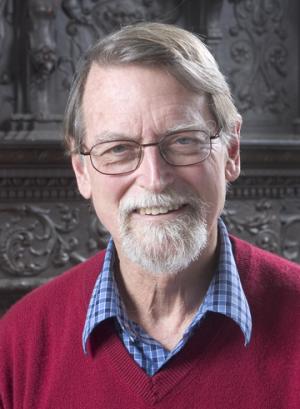<Back to Index>
- Mathematician
David Bryant Mumford,
1937
PAGE SPONSOR


David Bryant Mumford (11 June 1937) is an American mathematician known for distinguished work in algebraic geometry, and then for research into vision and pattern theory. He won the Fields Medal and was a MacArthur Fellow. In 2010 he was awarded the National Medal of Science. He is currently a University Professor Emeritus in the Division of Applied Mathematics at Brown University.
Mumford was born in Worth, West Sussex in England, of an English father and American mother. His father William started an experimental school in Tanzania and worked for the then newly created United Nations.
In high school, he was a finalist in the prestigious Westinghouse Science Talent Search. After attending the Phillips Exeter Academy, Mumford went to Harvard, where he became a student of Oscar Zariski. At Harvard, he became a Putnam fellow in 1955 and 1956. He completed his Ph.D. in 1961, with a thesis entitled Existence of the moduli scheme for curves of any genus.
He met his first wife, Erika Jentsch, at Radcliffe College. After Erika died in 1988, he married his second wife, Jenifer Gordon.
He and Erika had four children. Steve (born 1960) is a published artist residing in New York City, Peter (born 1962) is a professional photographer and web developer living in Seattle, Jeremy (born 1969) is a historian, while Suchitra (born 1970, now Suchitra Baranoff) has worked for more than fifteen years in the field of international adoption.
Mumford's work in geometry combined traditional geometric insights with the latest algebraic techniques. He published on moduli spaces, with a theory summed up in his book Geometric Invariant Theory, on the equations defining an abelian variety, and on algebraic surfaces.
His books Abelian Varieties (with C. P. Ramanujam) and Curves on an Algebraic Surface combined the old and new theories. His lecture notes on scheme theory circulated for years in unpublished form, at a time when they were, beside the treatise Éléments de géométrie algébrique, the only accessible introduction. They are now available as The Red Book of Varieties and Schemes.
Other work that was less thoroughly written up were lectures on varieties defined by quadrics, and a study of Goro Shimura's many papers from the 1960s.
Mumford’s research did much to revive the classical theory of theta functions, by showing that its algebraic content was large, and enough to support the main parts of the theory by reference to finite analogues of the Heisenberg group. This work on the equations defining abelian varieties appeared in 1966–7. He published some further books of lectures on the theory.
He also was one of the founders of the toroidal embedding theory; and sought to apply the theory to Gröbner basis techniques, through students who worked in algebraic computation.
In a sequence of four papers published in the American Journal of Mathematics between 1961 and 1975, Mumford explored pathological behavior in algebraic geometry, that is, phenomena that would not arise if the world of algebraic geometry were as well behaved as one might expect from looking at the simplest examples. These pathologies fall into two types: (a) bad behavior in characteristic p and (b) bad behavior in moduli spaces.
Mumford's philosophy in characteristic p was as follows:
- "A nonsingular characteristic p variety is analogous to a general non-Kähler complex manifold; in particular, a projective embedding of such a variety is not as strong as a Kähler metric on a complex manifold, and the Hodge - Lefschetz - Dolbeault theorems on sheaf cohomology break down in every possible way."
In the first Pathologies paper, Mumford finds an everywhere regular differential form on a smooth projective surface that is not closed, and shows that Hodge symmetry fails for classical Enriques surfaces in characteristic two. This second example is developed further in Mumford's third paper on classification of surfaces in characteristic p (written in collaboration with E. Bombieri). This pathology can now be explained in terms of the Picard scheme of the surface, and in particular, its failure to be a reduced scheme, which is a theme developed in Mumford's book "Lectures on Curves on an Algebraic Surface". Worse pathologies related to p-torsion in crystalline cohomology were explored by Luc Illusie.
In the second Pathologies paper, Mumford gives a simple example of a surface in characteristic p where the geometric genus is non-zero, but the second Betti number is equal to the rank of the Néron - Severi group. He also conjectures that the Kodaira vanishing theorem is false for surfaces in characteristic p. In the third paper, he gives an example of a normal surface for which Kodaira vanishing fails. The first example of a smooth surface for which Kodaira vanishing fails was given by Michel Raynaud in 1978.
In the second Pathologies paper, Mumford finds that the Hilbert scheme parametrizing space curves of degree 14 and genus 24 has a multiple component. In the fourth Pathologies paper, he finds reduced and irreducible complete curves which are not specializations of non-singular curves.
These sorts of pathologies were considered to be fairly scarce when they first appeared. But recently, R. Vakil in a paper called "Murphy's law in algebraic geometry" has shown that Hilbert schemes of nice geometric objects can be arbitrarily "bad", with unlimited numbers of components and with arbitrarily large multiplicities.
In three papers written between 1969 and 1976 (the last two in collaboration with E. Bombieri), Mumford extended the Enriques - Kodaira classification of smooth projective surfaces from the case of the complex groundfield to the case of an algebraically closed groundfield of characteristic p. The final answer turns out to be essentially as the answer in the complex case (though the methods employed are sometimes quite different), once two important adjustments are made. The first is that one may get "non-classical" surfaces, which come about when p-torsion in the Picard scheme degenerates to a non-reduced group scheme. The second is the possibility of obtaining quasi elliptic surfaces in characteristics two and three. These are surfaces fibered over a curve where the general fiber is a curve of arithmetic genus one with a cusp.
Once these adjustments are made, the surfaces are divided into four classes by their Kodaira dimension, as in the complex case. The four classes are: a) Kodaira dimension minus infinity. These are the ruled surfaces. b) Kodaira dimension 0. These are the K3 surfaces, abelian surfaces, hyperelliptic and quasi - hyperelliptic surfaces, and Enriques surfaces. There are classical and non-classical examples in the last two Kodaira dimension zero cases. c) Kodaira dimension 1. These are the elliptic and quasi - elliptic surfaces not contained in the last two groups. d) Kodaira dimension 2. These are the surfaces of general type.
Mumford was awarded a Fields Medal in 1974. He was a MacArthur Fellow from 1987 to 1992. He won the Shaw Prize in 2006. In 2007 he was awarded the Steele Prize for Mathematical Exposition by the American Mathematical Society. In 2008 he was awarded the Wolf Prize; on receiving the prize in Jerusalem from Shimon Peres, Mumford announced that he was donating half of the prize money to Birzeit University in the Palestinian territories and half to Gisha, an Israeli organization that advocates for the right to education and freedom of movement of Palestinians. In 2010 he was awarded the National Medal of Science.
He was elected President of the International Mathematical Union in 1995 and served from 1995 to 1999.
In 2002, Mumford wrote a book with Caroline Series and David Wright on the visual geometry of limit sets: Indra's Pearls: The Vision of Felix Klein.
More lately, he worked on pattern theory. In 2010, he published a book Pattern Theory: The Stochastic Analysis of Real-World Signals with Agnès Desolneux.